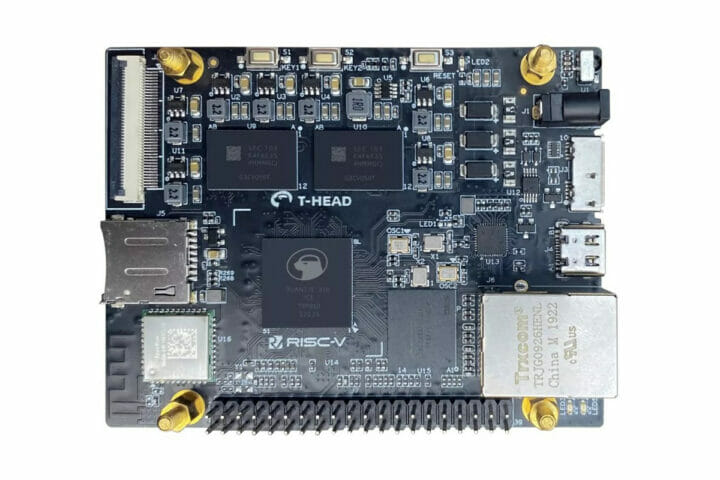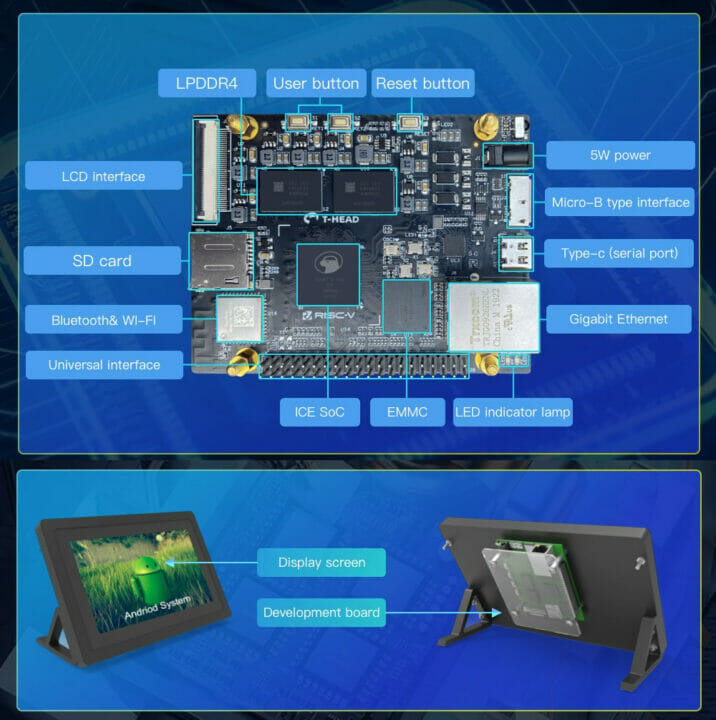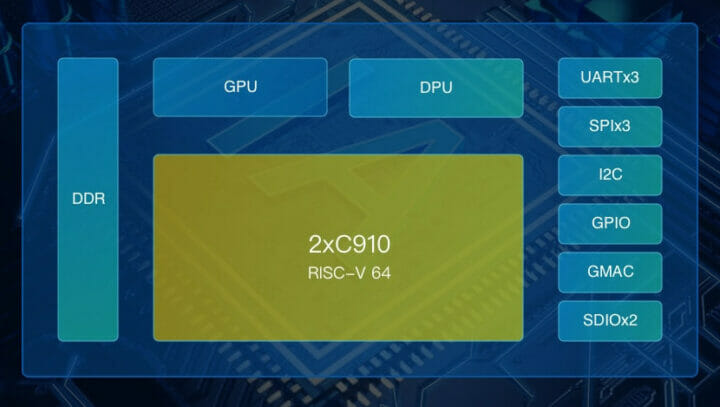The very first RISC-V single board computer with a 3D GPU reveals itself with “Alibaba T-head RVB-ICE” SBC available for pre-order for $399 together with a 7-inch display. The board is based on Alibaba T-Head “ICE” dual-core XuanTie C910 RISC-V processor with a Vivante GC8000UL GPU, and follows the announcement of Android 10 being ported to a RISC-V board earlier this year.
Besides the dual-core RISC-V processor clocked at 1.2 GHz, the board is equipped with 4GB LPDDR4, 16GB eMMC flash, and offers Gigabit Ethernet, WiFi and Bluetooth connectivity, as well as a 48-pin GPIO header. But it lacks HDMI output, relying on an LCD interface instead, as well as full-size (Type-A) USB ports with only one micro USB 3.0 OTG port, and a USB-C port for serial console.
 Alibaba RVB-ICE specifications:
Alibaba RVB-ICE specifications:
- SoC – Alibaba T-Head ICE with dual-core XuanTie C910 RISC-V processor @ 1.2 GHz, Vivante GC8000UL GPU, NPU
- System Memory – 4GB LPDDR4
- Storage – 16 GB eMMC flash, MicroSD card slot
- AI Accelerator – NPU present
- Display – RGB888 LCD interface up to 1080p; the devkit includes a 7-inch capacitive touchscreen display (LCD) with 1024×600 resolution
- Networking
- Gigabit Ethernet RJ45 port
- WiFi and Bluetooth
- USB – 1x micro USB 3.0 OTG port, 1x USB-C port for serial and power
- Expansion – 2x 24-pin header with GPIOs, 2xUART, I2C, 1x SPI, ADC
- Misc – 2x User buttons, 1x reset button, 1x LED
- Power Supply – 5V via power barrel (or USB-C port according to the specs)
The board will support both Android 10 and Debian 11 with 3G GPU acceleration. The Android 10 RISC-V Github repo has not been updated for 5 months, and I can not find documentation, but there’s an email occ_thead <at> service.alibaba.com where it might be possible to get the BSP before or more likely after pre-ordering the board (TBC). [Update: Some documentation is available on T-Head website, but only in Chinese at this time]
Last time around there was also mention of “4Kp60 HEVC/AVC/JPEG decoding ability”, but this is not listed in the specifications, and a VPU does not show up at all on the block diagram of the processor. There’s a DPU (Display Processor Unit) but that’s only for video output.
The NPU is not shown either, but Sipeed says it is present. We also learn there are currently 80 units of the development kit, and shipping is expected to take place next month, and the board was announced at the CHIPS Alliance Fall Workshop yesterday:
Porting Android to RISC-V – Guoyin Chen and Han Mao: Android OS has a significant share in the edge and terminal device market. In the past year, Alibaba T-Head has spent tremendous effort porting Android 10 to the RISC-V instruction set architecture. The Android ecosystem is rather complicated. Though we are still far from being done, there is already good progress being made, especially on some of the key aspects such as Android NDK, Bionic, ART and Chrome. This session will share insights on how to facilitate those under RISC-V. The work is currently being done on a XuanTie ICE dev board, which has two cores of the XuanTie C910 RISC-V processor running at 1200MHz.
The Alibaba RVB-ICE RISC-V board is rather expensive right now because it is manufactured in low quantity, and software support is likely much worse than on Arm. Everything will take time. I’d expect lower-cost RISC-V boards with GPU to be announced by the end of the year or early 2022, notably the successor of BeagleV Starlight which is planned for Q1, and might even use Alibaba ICE chip (TBC).

Jean-Luc started CNX Software in 2010 as a part-time endeavor, before quitting his job as a software engineering manager, and starting to write daily news, and reviews full time later in 2011.
Support CNX Software! Donate via cryptocurrencies, become a Patron on Patreon, or purchase goods on Amazon or Aliexpress







Great.
But at least one mini DP output might be sufficient…
Although limited in function ( software needs writing ) this from earlier in year was interesting.
” AMD Radeon RX 6700 XT Graphics Card Running on RISC-V System for the First Time“
There is already an etnaviv driver in Mesa (for Vivante GPU) for years. What do you mean by software needs writing ? There are already several packages fullfilled Linux distribution for RISC-V, including Debian (so they use it here) and Ubuntu.
ARM domination means I look at a RISC-V core name and I’m not sure if it has performance like a Cortex-M, Cortex-A53, or Cortex-A72.
Lucky, if there are comparison experiences. Try to abstract from a TOPS for NPU cores what neural networks are capable of at every single SBC?
While compiling a Kernel with equal configuration is a mean to compare CPUs there are no established (everyone says ‘yes, sure, that one’) reference applications for GPU (games, benchmark tools) or NPU (benchmark tools) cores?
I think this core should be compareable to an A73 hz for hz.
What makes you think so? It’s lower clocked overall, a revision of core used in Nezha, and as much as that board is pinned down by memory issues I do not think it is holding back all the performance. Unless we get a direct answer measured in CoreMarks/MHz or DMIPS/MHz, which may or may not include vector unit in benchmarks, we can’t even speculate on performance much.
So, as we expected in January, it’s a patched up, production-grade Nezha. Shame it does not have Hifi4 DSP and it will take some more time before driver for this GPU gets made by Etnaviv developers, but I’ll take it over D1.